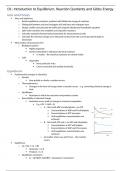Lecture notes
Chemistry for Biology Students (CHEM0010) Notes - Ions and Chemical Forces
- Institution
- University College London (UCL)
Explore Chemistry for Biology Students with these specialized notes crafted for Year 1 students at University College London. Within this document, unravel the intricacies of ions and chemical forces, exploring concepts such as equilibrium, reaction quotients, Gibbs energy, protons, pH, solubility,...
[Show more]



